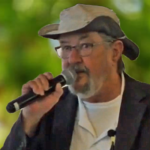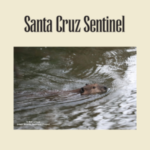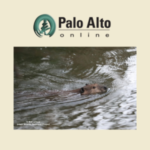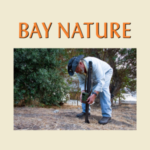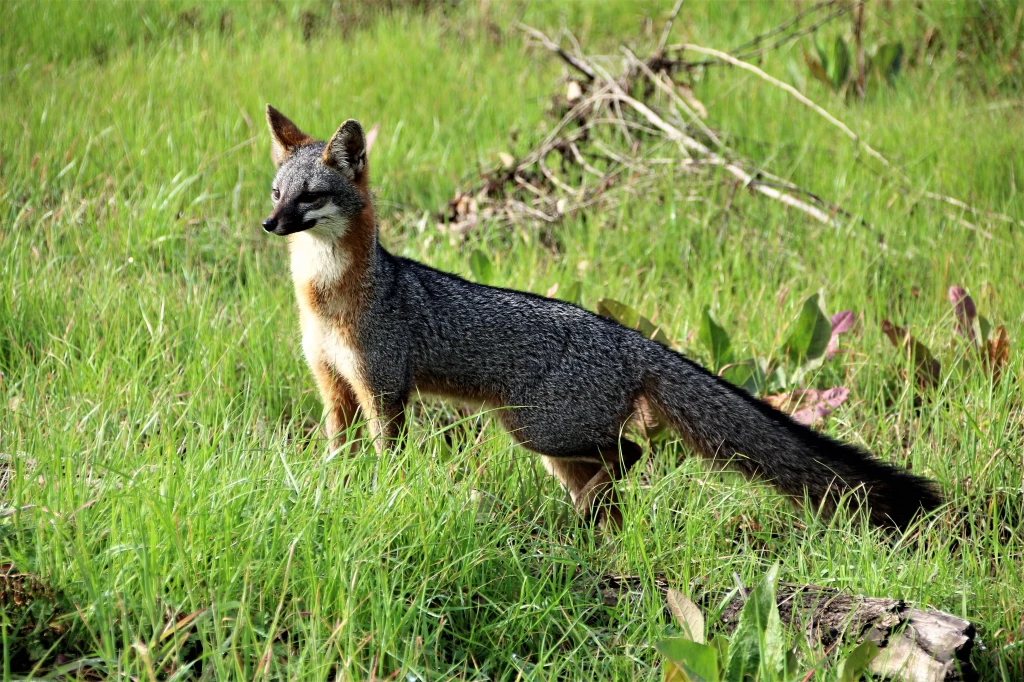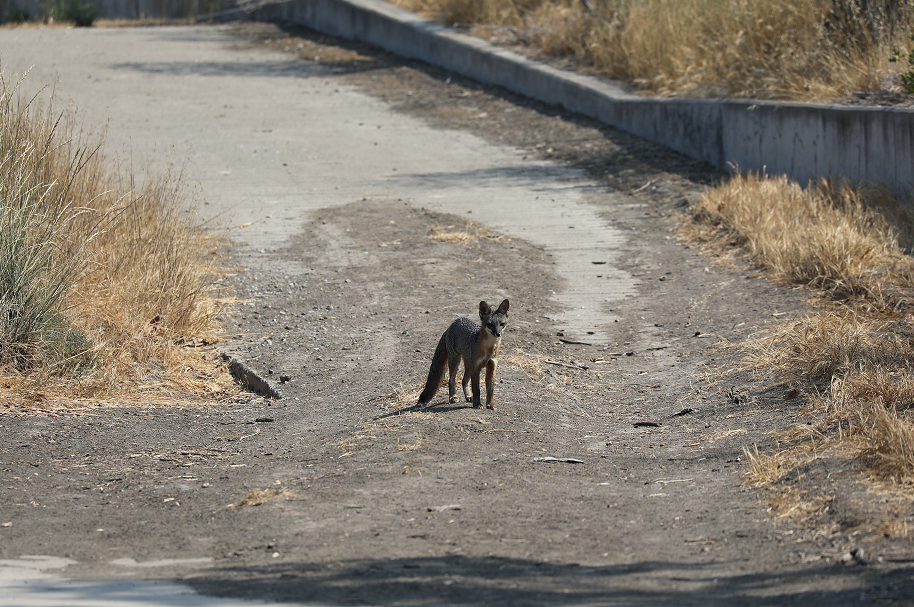Gray Foxes Laimos and Big Eyes Return Home
by William C. Leikam
President, CEO & Co-founder, Urban Wildlife Research Project
When Laimos and Big Eyes first came into the woods along Matadero Creek, they marked the territory as theirs and they even marked every single one of the thirteen trail cameras that I had posted, both in the woods beside the creek and at the water treatment plant. The overall home range territory was, as far as I could determine, about one half square mile. These two foxes established their natal den well within their home range and that area was theirs and theirs alone. They marked with their scat, their urine and their scent glands to let every other mammal; the raccoons, the opossums and others in their territory that it was their property.
They proved their ownership when a young female gray fox with a floppy ear and a green ear tag came into their area. We called her Flop. Both Laimos and Big Eyes relentlessly fought and chased Flop, until she could no longer take the harassment. She went back to her home range, likely where she was born, over near Shoreline Amphitheater, about two miles away. (See Gray Fox Report: December 2019 for reference to Flop’s return to Shoreline.)

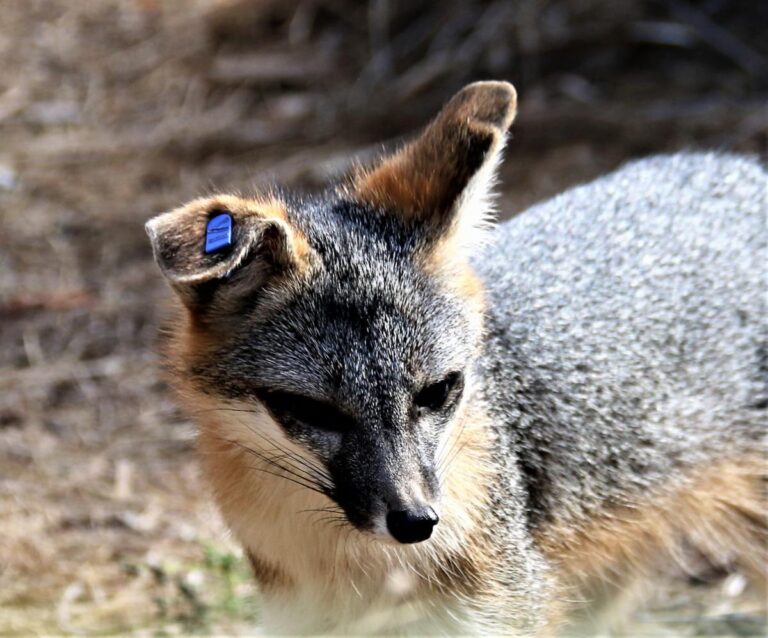
Coming of the Raccoons:
Last year, 2022 there was a gathering of raccoons along the creek, two of which moved into the gray fox’s natal den area. The two raccoons were fearless, not only of the foxes but of me too. One I called Bully because that’s what he was, a bully when it came to other raccoons and the foxes. I named the other raccoon Pesky because she was just simply a bother for the foxes. The foxes tried to dislodge both raccoons from their area, but that failed.
When it was obvious to the foxes that the raccoons were not going to leave them alone, nor were they going to leave the natal den area, the foxes moved their den about 300 feet upstream and on a hillside. There they lived only part time. They established a secondary place to sleep during the course of the day, out on what I’ve come to call Pond Road; a dirt and gravel road that connects to the overflow channel.
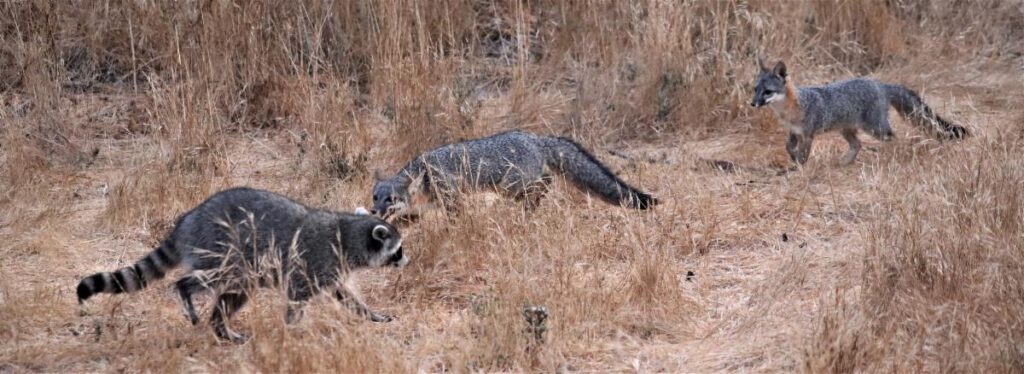
Coming of the Storms:
At first when the torrential rains began lashing the west coast this year, the creek flooded well over its banks. Water flowed from levee to levee. During it all, the raccoons and the foxes handled the 13 storms that battered the region surprisingly well.
As the water resided and I was able to access all of my trail cameras, I noticed a change down in the gray fox den area: No raccoons came from the underbrush when I swapped out SD cards from the trail camera back in those woods. And then, I noticed too that the gray foxes spent less and less time sheltering and sleeping along Pond Road. More often than not when I went back into the woods to take care of my trail cameras, the foxes came from the surrounding thicket where once only Pesky and Bully emerged.
As of this writing, it’s clear that the storms pushed the two raccoons out and that has allowed Laimos and Big Eyes the freedom to move back into their original natal den.
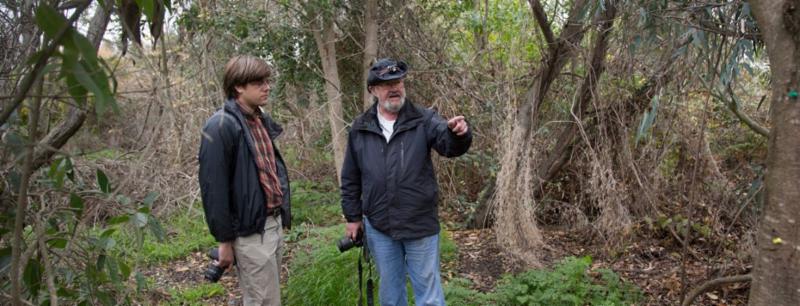
I. Gray Fox Population & General Health
As of this date, we have two adult gray foxes living in the Palo Alto Baylands Nature Preserve. These two foxes appear to be in good health. There is no indication in their scat that anything internal is breaking down.
II. UWRP News & Updates
On May 25, Bill Leikam “The Fox Guy” will be presenting to the Kiwanis Club of Palo Alto at the Sheraton Hotel. Join Bill in this upcoming engaging multimedia lecture to experience the secret lives of gray fox pups as they learn how to survive in their ever-changing world.
 The ‘Triggered By Motion’ Experience
The ‘Triggered By Motion’ Experience
The UWRP is excited to present our newest video documentary featuring Bill Leikam’s participation in the global research project “Triggered By Motion”, a world-wide exhibit of citizen scientists from 21 locations using camera traps to learn about local urban wildlife. Join Bill on his journey between California and Zürich, Switzerland, as he experiences the breathtaking exhibition in person!
The UWRP has just launched a brand new website, courtesy of Milena at DesignerForChange. Please visit us at our new domain, urbanwildliferesearchproject.org (not .com!) to stay in the loop on our conservation activity, event announcements, and updates about gray foxes Big Eyes and Laimos in the Palo Alto Baylands.
Today, Bill is the world’s leading authority on the gray fox. This book is an account of his experiences among the gray foxes of the Baylands, a tale of life and death, of growth and loss. Stay for a while and go exploring with the Fox Guy. Find it today at Barnes & Noble or DiAngelo Publications.
 Coming soon:
Coming soon:
Look forward to an upcoming interview between Bill and Dr. Annabelle Dufourcq, associate professor of metaphysics and philosophical anthropology, philosophy, theology and religious studies at Radboud University Nijmegen, The Netherlands — for a project of hers on ethology.
Read more about UWRP in the news:
III. UWRP Research Objectives
Within the permit that allows the Urban Wildlife Research Project to conduct its study of the behavior of the gray fox at the Palo Alto Baylands Nature Preserve, the objectives covered area:
Monitoring of urban gray fox denning sites in Palo Alto Baylands: This is being accomplished during the period when the gray foxes use a den site. It is one of the prime locations for gathering most of the behavioral data of the litter and for adults alike.
Assessment of status and population trends of Baylands urban gray foxes: Since January 2019 a pair of resident gray foxes have claimed territory at the Palo Alto Baylands Nature Preserve.
Identification of habitat features that promote the presence of urban gray foxes: After considering this and talking with people who know how to restore habitats, we need to assess what kinds of plants, including the Alkaline Saltbush, would grow best along the edge of the saltwater channel and alongside the marsh. We need to grow a permanent habitat that contains the corridors and plant it as soon as possible. We’ll keep an eye on this as this is a critical link between the southern region of the Baylands and the northern region.
Assessment of reproductive success and identification of factors that promote successful reproduction: Open the pinch-point along Matadero Creek by developing thickets that link one area to another, instead of the present “islands”.
Identification and assessment of possible dispersal travel routes: Dispersal routes move between the Palo Alto Baylands Nature Preserve and the Shoreline region over in Mountain View. In a north-westerly direction the dispersal corridors run just behind the homes bordering the marshlands.


